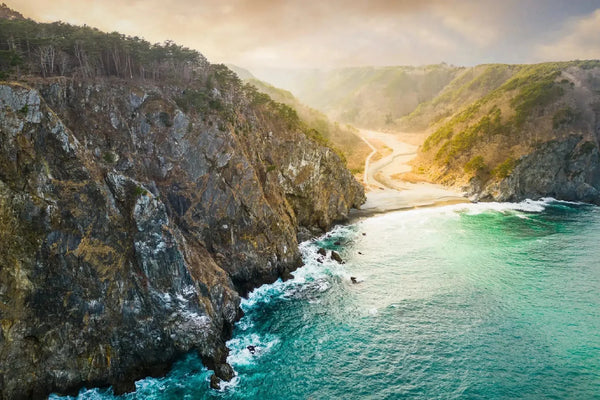
Jump to:
Japan's Tohoku region is a treasure trove of natural beauty, unique history and mouth watering cuisine.
Often overlooked by tourists in favor of more well-known destinations like Tokyo or Kyoto, Tohoku offers a glimpse into a side of Japan that many visitors never see.
Rugged coastlines? Check. Ancient temples? You’ll find those here. Warm-hearted locals, who gladly welcome guests and love to throw a good festival? Aplenty in Tohoku!
This northern region is a perfect destination for those looking to venture off the beaten path and experience Japan's rural charm. In this edition of the Japanese Taste blog, we'll explore what makes Tohoku special and why it should be on the itinerary for travelers to Japan – especially those who love Japanese cuisine.
Where Is Tohoku? Atop Honshu, Tohoku Is Japan’s Northern Frontier

Tohoku, which means "northeast" in Japanese, is located in the northern part of Japan's main island, Honshu.
It's made up of six prefectures: Aomori, Akita, Iwate, Yamagata, Miyagi and Fukushima. Each of these prefectures has its own unique character and attractions.
At the top, Aomori is connected to the other northern Japan bastion of Hokkaido, via the Seikan Tunnel (across the Tsuruga Strait).
On the other end, the most southern areas of Tohoku are within easy reach of Tokyo even for a day trip. Though to be honest, thanks to Japan’s expansive and impressive rail network. And what’s more, once you see what Tohoku has to offer, you’ll want to spend a whole week here.
North To South: The Geographic Rundown Of Tohoku’s Prefectures

Aomori, the northernmost prefecture of Tohoku and of Honshu island, is famous for its apple orchards and the Nebuta Matsuri, a spectacular summer festival featuring enormous, illuminated floats. Aomori is also home to the scenic Shirakami-Sanchi, a UNESCO World Heritage site known for its virgin beech forests. And Hirosaki Castle, one of the 12 original castles, is not to be missed.
Akita is known for its namesake dog breed, the Akita (of course). But this part of Japan also boasts a rich rice-growing tradition. Akita prefecture is well known for its sake production, taking advantage of the high-quality rice and pure water sources in the region.
Iwate boasts some of Japan's most beautiful coastlines, including the rugged Sanriku Coast (one of three national parks in the Tohoku region that you really ought to see). It's also home to the historic town of Hiraizumi, where you can find Chusonji Temple, a UNESCO World Heritage site known for its golden hall. Star Japanese baseball player Shohei Ohtani? Yup, he’s from Iwate, too.
Yamagata is a haven for nature lovers, with its iconic snow monsters (trees covered in heavy snow) on Mount Zao in winter and the scenic Mogami River. Yamagata is indeed famous for its cherries and prized wagyu Yamagata beef.
Miyagi prefecture is home to the region's largest city, Sendai, known as the "City of Trees." The prefecture is famous for its oysters and for Matsushima Bay, considered one of Japan's three most scenic views.
Lastly (and definitely not least), Fukushima is known for its hot spring resorts, particularly in the Aizu region. Despite the challenges it has faced, Fukushima continues to be a beautiful and welcoming place, famous for its fruit (especially peaches) and sake.
Each of these prefectures contributes Tohoku's cultural distinction and natural beauty, making the region a diverse and well worthy place to explore.
Famous Places & Top Destinations In Tohoku

Tohoku is packed with stunning locations that showcase Japan's natural beauty and cultural heritage.
As is the case with travel in Japan, don’t feel like you have to see it all – at least, not all in one trip. Pick a few spots to see and things to do, and then go more in-depth with that. Also, when you go is a pretty important factor in determining where to go and what to do, which we’ll get to later.
Matsushima Bay in Miyagi is a collection of pine-covered islands that has inspired poets and artists for centuries. Take a boat tour to appreciate the full beauty of this iconic landscape. Dine on fresh seafood at the local fish market; the kaisendon is particularly good here, as are the famous oysters. Matsushima Bay can easily be enjoyed as a day trip from your base in Sendai.
Or you can include an overnight here or in Kesennuma, which you can explore the next morning before taking the Pokemon train (yes, that’s a thing, and you can book it 30 days ahead of time!) and/or enjoying the nearby Geibikei gorge.
The samurai district of Kakunodate in Akita feels like stepping back in time. With its well-preserved samurai houses and weeping cherry trees, it's especially beautiful during spring.
Mount Zao, straddling Yamagata and Miyagi prefectures, is famous for its "snow monsters" in winter. Here, trees coated in snow and ice that take on eerie shapes. In summer, you can hike around its stunning crater lake.
Hirosaki Castle in Aomori is one of Japan's best spots for cherry blossom viewing. The castle grounds are home to over 2,500 cherry trees, creating a pink wonderland in spring.
The Oirase Stream in Aomori offers a picturesque hiking trail along crystal-clear waters and numerous waterfalls. It's particularly stunning in autumn when the surrounding forest turns golden and red.
What Is Tohoku Famous For?

Tohoku is renowned for its natural beauty, traditional crafts and hearty cuisine.
The region is famous for its onsen hot springs, with notable onsen towns like Naruko in Miyagi and Nyuto in Akita offering rejuvenating baths with spectacular views.
Tohoku's festivals are legendary. The Nebuta Matsuri in Aomori and the Kanto Matsuri in Akita are summer spectacles you’ll definitely want to see, featuring enormous floats and impressive feats of balance respectively. Book well in advance, both accommodations and trains/transport, as these festivals are immensely popular (and with good reason).
The Tohoku region is also known for its crafts. For example, the Kokeshi dolls, simple wooden dolls with hand-painted features, originated in Tohoku and make for unique souvenirs.
Tohoku Eats: From Seafood & Ramen To Amazing Local Beef, Chicken, Fruit & More

Tohoku's cuisine is characterized by hearty, warming dishes perfect for the region's cold winters.
For starters, don’t miss the amazing seafood that’s found throughout much of the Tohoku region!
Aomori’s Furukawa fish market is popular and well regarded across Japan for its Nokke-don, a version of kaisendon (sashimi served atop bowls of rice without vinegar) where you go from stall to stall in the market with a strip of tickets, and can choose a variety of items from different stalls to top your rice bowl.
You can find other versions of kaisendon around different towns and cities in Tohoku. But the grilled and steamed fish dishes here are also great. And of course, the aforementioned oysters.
Do you love ramen? So do we! Did you know that the town of Kitakata in Fukushima prefecture eats more ramen per capita than any other city in Japan? Kitakata ramen is its own style, and you can find it elsewhere in Japan too; but really, go to Kitakata and enjoy some of that hearty ramen on a winter’s day here.
Wanko soba from Iwate: Tiny bowls of soba noodles served rapid-fire until you can't eat anymore.
Kiritanpo from Akita: Cylinders of mashed rice grilled and often served in a hot pot. Akita is also well known for its regional “jidori” (local craft) chicken, which you can enjoy at a yakitori-ya-san along with some local sake.
Imoni from Yamagata: A hearty taro and meat soup often enjoyed at outdoor parties in autumn. Of course, as mentioned earlier, Yamagata beef is a wagyu you won’t want to skip, so be sure to eat some here – sukiyaki or shabu shabu are great in the winter, especially!
Gyutan (beef tongue) from Sendai: Thinly sliced and grilled to perfection. If that makes you a bit squeamish, gyutan is usually cut and prepared in ways that are both visually appealing and extremely tasty & tender.
Ichigo-ni from Aomori: Despite its name meaning "strawberry stew," this is actually a savory sea urchin and abalone soup.
Train Lines And Transportation In Tohoku
The Tohoku Shinkansen bullet train is the main artery connecting Tokyo to the region, running all the way to Aomori. This high-speed line makes it easy to reach major cities like Sendai, Morioka and Aomori.
For exploring within the region, the JR East Pass (Tohoku area) offers unlimited travel on JR trains, including some shinkansen services. The Japan Rail Pass can also be used on most JR lines in Tohoku (except the fastest shinkansen express trains, so be sure to check); however, the best bet often works out to be either a regional pass or point-to-point tickets.
Local train lines like the scenic Gono Line (“Resort Shirakami”) along the Sea of Japan coast offer beautiful journeys through the countryside. On select days, JR runs its Pokemon train service along some lines in Miyagi and Iwate prefectures; check the schedules and book (literally!) at 10am of the day they go on sale, typically 30 days out (be sure to calculate that in Japan time zone, not your local).
In more rural areas, rental cars can be a good option for flexibility, especially when visiting off-the-beaten-path locations.
How To Get To Tohoku From Tokyo
The easiest and fastest way to reach Tohoku from Tokyo is by shinkansen. The journey to Sendai, the largest city in Tohoku, takes about 1.5 hours. To reach Aomori at the northern tip of Honshu, it's about 3 hours.
Alternatively, overnight buses offer a budget-friendly option, although the journey is much longer.
For those short on time, there are flights from Tokyo to major cities in Tohoku, with flight times around 1 hour. Airports in Japan tend to be a breeze, so even allowing time to/from and at the airport, flying Tokyo-Aomori or Osaka-Sendai is often a better scenario.
Why Is Tohoku Worth Visiting?

Tohoku offers a side of Japan that many visitors never see. Here, you can experience Japan's rural heart, where traditions are still alive and the pace of life is a bit slower.
The region's natural beauty is stunning and diverse, from coastlines to mountains to forests. Outdoor enthusiasts will find plenty to love, including excellent hiking, skiing and hot springs.
Tohoku's festivals are some of the most spectacular in Japan, offering unforgettable cultural experiences.
The food scene in Tohoku is a delight for culinary adventurers. Each prefecture has its own specialties, often using local ingredients in unique ways.
Perhaps most importantly, by visiting Tohoku, you're supporting a region that has shown incredible resilience in the face of natural disasters. The warm welcome you'll receive from locals eager to share their home with visitors is truly special.
Tohoku may not have the name recognition of Kyoto, Osaka or Tokyo, but for those willing to venture north in Japan, it offers vast rewards for the intrepid traveler.


0 comments